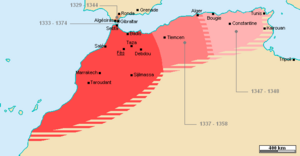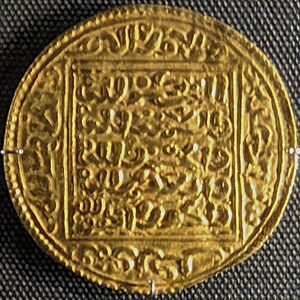Abu al-Hasan Ali ibn Othman facts for kids
Quick facts for kids Abu al-Hasan Ali ibn Othman |
|||||
|---|---|---|---|---|---|

Dirham minted under the reign of the Marinid ruler Abu al-Hasan ibn Uthman.
|
|||||
| Sultan of Morocco | |||||
| Reign | August 1331 – 1348 | ||||
| Predecessor | Abu Sa'id Uthman II | ||||
| Successor | Abu Inan Faris | ||||
| Born | c. 1297 Fez |
||||
| Died | 24 May 1351 (aged 53–54) High Atlas |
||||
| Burial | Chellah | ||||
| Issue | Abu Inan Faris | ||||
|
|||||
| Dynasty | Marinid | ||||
| Father | Abu Sa'id Uthman II | ||||
| Religion | Islam | ||||
Abu Al-Hasan 'Ali ibn 'Othman (around 1297 – 24 May 1351) was a powerful ruler, known as a sultan, of the Marinid dynasty. He ruled in Morocco from 1331 to 1348.
During his time, Abu Al-Hasan made his empire much bigger. He captured Gibraltar from the Castilians in 1333. He also took control of lands in North Africa, including Tlemcen and Ifriqiya (parts of what are now Algeria and Tunisia). For a short time, his empire was as large as the earlier Almohad Caliphate.
However, he faced a big challenge when Arab tribes rebelled against him. He was forced to retreat and lost many of his supporters. His son, Abu Inan Faris, then took control in Fez. Abu Al-Hasan later died while in exile in the High Atlas mountains.
Contents
Early Life and Family
Abu al-Hasan was the son of the Marinid ruler Abu Sa'id Uthman II. His mother was from Abyssinia (modern-day Ethiopia). Because of his dark skin, he was sometimes called the 'Black Sultan' of Morocco.
He became sultan in 1331 after his father passed away. To make his kingdom stronger, Abu al-Hasan married Fatima. She was the daughter of the Hafsid ruler Abu Yahya Abu Bakr II from Ifriqiya. This marriage helped create an alliance between the Marinids and the Hafsids against their rivals, the Zayyanid dynasty of Tlemcen.
Major Campaigns
Abu al-Hasan was a skilled military leader. He led several important campaigns that expanded his empire.
Taking Gibraltar
In 1309, Castilian troops had captured Gibraltar from the Muslim-ruled Emirate of Granada. In 1333, the ruler of Granada, Muhammad IV, asked Abu al-Hasan for help.
Abu al-Hasan sent a Moroccan army to Algeciras, led by his son Abd al-Malik Abd al-Wahid. About 7,000 soldiers crossed the Strait of Gibraltar in February 1333. The Castilians were busy with their new king, Alfonso XI, so they were slow to react. This allowed the Moroccan forces to lay siege to Gibraltar.
By June, the people in Gibraltar were starving. They had run out of food and were desperate. On June 17, 1333, the Castilian commander surrendered Gibraltar. The defenders were allowed to leave with honor because they had fought so bravely.
News of Gibraltar's capture was celebrated in Morocco. People were overjoyed that the city was back under Muslim rule. However, this success also made some people in Granada worried about the Marinids becoming too powerful. Muhammad IV was even assassinated a few months later.
Despite this, Abu al-Hasan was not ready to invade Spain. He was busy fighting Tlemcen. A peace treaty was signed in 1334 between Castile, Granada, and Morocco, lasting four years.
Conquering Tlemcen
The ruler of Tlemcen, Ibn Tashufin, started attacking Ifriqiya. He besieged Béjaïa and sent an army into Tunisia. The Hafsid king, Abu Yahya Abu Bakr II, had to flee.
Since Abu al-Hasan was married to a Hafsid princess, the Hafsids asked him for help in 1334. This gave Abu al-Hasan a reason to invade Tlemcen.
In early 1335, Marinid forces attacked Tlemcen from the west. They also sent a navy to help the Hafsids from the east. The Zayyanids were pushed back into the city of Tlemcen. Abu al-Hasan then began a long siege of Tlemcen. His siege camp became like a small city itself.
In 1337, after a two-year siege, Tlemcen finally fell to the Marinids. Ibn Tashufin died during the fighting. His brothers were captured and killed. The Sultanate of Tlemcen (which covered much of western Algeria today) was added to the Marinid empire. Abu al-Hasan received congratulations from many places, including Egypt and Mali. He now controlled the important trade routes across the Sahara Desert.
Battle of Tarifa
After these victories, in 1339, Abu al-Hasan was asked by Yusuf I of Granada to help fight the Castilians. A large Marinid army was gathered in Morocco. This made the Castilian king, Alfonso XI, end his disagreements with the Portuguese king.
In April 1340, a Castilian fleet sailed to attack the Marinid fleet near Ceuta. The Marinid fleet, led by Muhammad ibn Ali al-Azafi, destroyed the Castilian fleet in a naval battle near Gibraltar on April 5, 1340. The Castilian admiral was killed.
With the sea clear, Abu al-Hasan spent the summer moving his troops and supplies across the strait to Algeciras. He arrived with the main Marinid forces in August 1340. The Marinid army joined with Granadan forces in September and together they began to besiege Tarifa.
King Alfonso XI of Castile asked his father-in-law, King Afonso IV of Portugal, for help. In October 1340, a Portuguese fleet cut off the besiegers' supply line to Morocco. Meanwhile, Afonso IV led an army to join Alfonso XI. Together, they marched against the Marinid-Nasrid forces at Tarifa.
The Marinid-Nasrid forces were defeated at the Battle of Río Salado in October 1340. Abu al-Hasan had to retreat back to Algeciras. After this defeat, he stopped his campaigns in the Iberian Peninsula. A few years later, Alfonso XI of Castile easily took Algeciras in March 1344.
Taking Ifriqiya
In 1346, the Hafsid Sultan, Abu Bakr, died, leading to a fight over who would rule next. Several groups in Ifriqiya asked Abu al-Hasan for help. In a campaign in early 1347, Abu al-Hasan's Moroccan army swept through Ifriqiya. He entered Tunis in September 1347.
By bringing Morocco, Tlemcen, and Ifriqiya together, Abu al-Hasan had created an empire as vast as the earlier Almohad empire. People at the time noticed this impressive achievement.
Revolt and Death
However, Abu al-Hasan tried to control the Arab tribes too strictly. They rebelled against him. In April 1348, they defeated his army near Kairouan.
His son, Abu Inan Faris, who was governing Tlemcen, returned to Fez and declared himself the new sultan. Tlemcen and the central Maghreb also rebelled. A Zayyanid ruler, Abu Sa'id Uthman II, was proclaimed king of Tlemcen.
Abu al-Hasan's fleet was destroyed by a storm on its way home near Bougie. The once-powerful sultan was left stranded in enemy territory. He managed to escape and join his supporters in Algiers. He gathered enough forces to try and retake Tlemcen, but he was defeated again.
Many of his former supporters left him. Abu al-Hasan was forced to go to Sijilmassa in southern Morocco, hoping to use it as a base. But Abu Inan's armies followed him, forcing Abu al-Hasan to flee to Marrakesh. In May 1350, Abu Inan defeated Abu al-Hasan again.
Abu al-Hasan fled into the high Atlas Mountains, seeking safety among the Hintata tribes. He was tired, sick, and had no resources left. In late 1350 or early 1351, he finally agreed to give up his throne to Abu Inan.
Abu al-Hasan died in May 1351, still in his mountain hiding place. His body was later moved by Abu Inan to the Marinid burial ground at Chellah, reportedly with much public sadness.
In 1352, Abu Inan Faris recaptured Tlemcen. He also took back the central Maghreb. He captured Béjaïa in 1353 and Tunis in 1357, becoming the ruler of Ifriqiya. In 1358, he had to return to Fez because of Arab opposition, where he was killed by his vizier (a high-ranking official).
See also
 In Spanish: Abu ul-Hasan ben Uthmán para niños
In Spanish: Abu ul-Hasan ben Uthmán para niños




